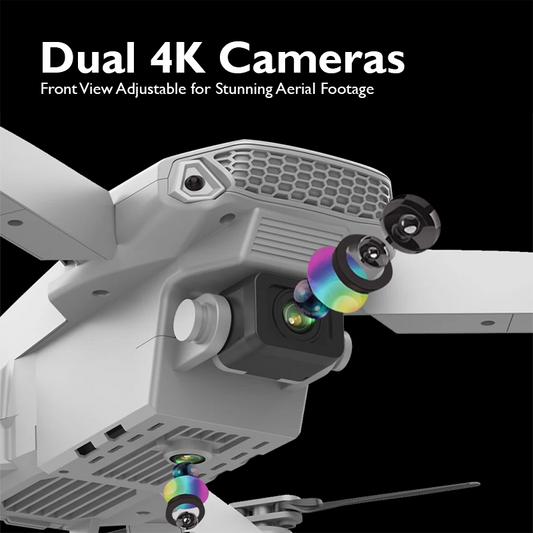How Drones are Contributing to Urban Air Quality Studies

In the perpetual battle for cleaner air in urban environments, innovative technologies are increasingly becoming indispensable allies. Among these modern marvels, drones have emerged as powerful tools revolutionizing the way we monitor and analyze urban air quality. With their agility, versatility, and advanced sensing capabilities, drones are ushering in a new era of precision in environmental research. In this article, we delve into how drones are contributing to urban air quality studies and reshaping our understanding of pollution dynamics in cities.
1. Understanding Urban Air Quality Challenges

Before delving into the role of drones, it's crucial to grasp the gravity of urban air quality challenges. As populations surge and urbanization accelerates, cities worldwide grapple with alarming levels of air pollution. Vehicular emissions, industrial activities, and urban sprawl all contribute to the accumulation of harmful pollutants such as particulate matter (PM), nitrogen oxides (NOx), and volatile organic compounds (VOCs). These pollutants not only degrade air quality but also pose severe health risks, including respiratory diseases and cardiovascular disorders.
Traditionally, monitoring air quality in urban areas relied on stationary ground-based stations. While these stations provide valuable data, their spatial coverage is limited, leaving gaps in understanding air pollution distribution across vast urban landscapes. Additionally, the static nature of these stations fails to capture the dynamic nature of pollution hotspots, hindering effective mitigation strategies.
2. Enter Drones: A Game-Changer in Air Quality Monitoring

Drones, equipped with state-of-the-art sensors and imaging technology, offer a dynamic solution to the shortcomings of traditional monitoring methods. These unmanned aerial vehicles (UAVs) can navigate urban environments with precision, accessing areas inaccessible to ground-based stations. By flying at varying altitudes and locations, drones provide comprehensive spatial coverage, allowing researchers to map air quality parameters across entire cities.
One of the key advantages of drones lies in their ability to collect real-time data, enabling rapid response to changing pollution patterns. Equipped with sensors capable of detecting a wide range of pollutants, including PM2.5, ozone, and carbon monoxide, drones offer a multi-dimensional view of urban air quality dynamics. This real-time monitoring capability is instrumental in identifying pollution sources, tracking pollutant dispersion, and assessing the effectiveness of pollution control measures.
3. Applications of Drone Technology in Urban Air Quality Studies
The versatility of drones extends beyond data collection, encompassing a wide array of applications in urban air quality studies:
i. Pollution Mapping:

Drones equipped with high-resolution cameras and gas sensors can generate detailed pollution maps, highlighting hotspots and identifying pollution sources. These maps provide valuable insights for urban planners and policymakers in devising targeted interventions to improve air quality.
ii. Emission Source Identification:
By conducting aerial surveys, drones can pinpoint sources of pollution, such as industrial facilities, traffic congestion points, and construction sites. This information facilitates targeted enforcement actions and regulatory measures to curb emissions from identified sources.
iii. Mobile Monitoring:

Unlike stationary monitoring stations, drones have the flexibility to monitor air quality in motion, following pollution plumes and tracking pollutant dispersion patterns. This mobile monitoring capability is particularly useful during events such as wildfires, where rapid assessment of air quality is critical for public health and safety.
iv. Air Quality Modeling:

Data collected by drones serve as inputs for air quality models, enabling researchers to simulate pollution dispersion patterns and forecast future air quality scenarios. These models aid in assessing the impact of urban development projects, transportation policies, and emission reduction strategies on air quality outcomes.
v. Public Health Surveillance:
Drones equipped with bioaerosol sensors can detect airborne pathogens and allergens, providing early warning systems for disease outbreaks and allergen exposure. This proactive approach to public health surveillance enhances preparedness and response measures, safeguarding community health.
4. Overcoming Challenges and Future Prospects

While drones offer immense potential in urban air quality studies, several challenges must be addressed to maximize their effectiveness:
i. Regulatory Hurdles: Regulatory frameworks governing drone operations vary globally, posing challenges for researchers seeking to deploy drones for air quality monitoring. Streamlining regulations and obtaining necessary permits are essential for widespread adoption of drone technology in environmental research.
ii. Data Integration and Analysis: The vast amounts of data generated by drones require sophisticated analytical tools and algorithms for interpretation. Integrating drone-derived data with existing monitoring networks and models is crucial for deriving actionable insights and informing decision-making.
iii. Cost Considerations: The initial investment in drone technology and sensor equipment can be significant, limiting access for smaller research institutions and organizations. Efforts to reduce costs through technological advancements and collaborative partnerships can democratize access to drone-based monitoring solutions.
In conclusion, drones are not just flying gadgets; they are transformative tools driving innovation in urban air quality studies. By providing unprecedented insights into pollution dynamics and enabling targeted interventions, drones are instrumental in the quest for cleaner, healthier cities. Embracing this technological revolution is essential for safeguarding public health and ensuring sustainable urban development in the face of growing environmental challenges.
Explore a variety of drones at our online drone store.Happy Flying!











